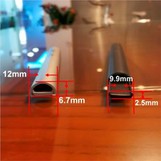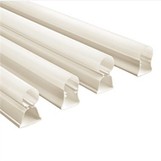Hey there! As a supplier of LED linear lights, I'm super excited to dive into the topic of what the efficiency of LED linear lights really means. So, let's get right into it.
First off, when we talk about the efficiency of LED linear lights, we're mainly looking at two key aspects: energy efficiency and luminous efficiency. Energy efficiency is all about how much electrical energy these lights can convert into light energy. And luminous efficiency is about how well they can produce visible light.
LED linear lights are known for their outstanding energy efficiency. Compared to traditional lighting sources like incandescent bulbs or fluorescent tubes, LEDs use a lot less electricity to produce the same amount of light. Incandescent bulbs waste a huge amount of energy as heat. They convert only about 10 - 20% of the electrical energy into light, while the rest turns into heat. That's just crazy, right?
On the other hand, LED linear lights can convert up to 80 - 90% of the electrical energy into light. This means they use way less power to achieve the same level of brightness. For example, if you have a big commercial space that needs a lot of lighting, switching to LED linear lights can lead to significant savings on your electricity bill. It's not just good for your wallet, but also for the environment as less energy consumption means a smaller carbon footprint.
Now, let's talk about luminous efficiency. The luminous efficiency of a light source is measured in lumens per watt (lm/W). A higher lm/W value means the light is more efficient at producing visible light. LED linear lights typically have a high luminous efficiency, often ranging from 80 - 150 lm/W or even higher in some advanced models.
This high luminous efficiency allows LED linear lights to provide a bright and uniform light distribution. Whether you're using them in a retail store to showcase products, in an office to create a comfortable working environment, or in a residential space for general lighting, they can do the job really well. The light they emit is also more focused and can be directed where it's needed, reducing light wastage.
One of the factors that contribute to the high efficiency of LED linear lights is their design. These lights are made up of multiple small LED chips arranged in a linear array. Each LED chip is highly efficient on its own, and when combined, they can produce a powerful and consistent light output.
Another advantage is that LED linear lights have a long lifespan. They can last for 50,000 hours or more, compared to traditional bulbs that may only last for a few thousand hours. This means you don't have to replace them as often, which saves you both time and money on maintenance.
Let's take a look at some of the different types of LED linear lights and how their efficiency plays a role. For instance, 24V LED Linear Light is a popular choice. The 24V power supply allows for better control and flexibility in installation. These lights are also energy - efficient, making them suitable for a wide range of applications, from under - cabinet lighting in kitchens to accent lighting in galleries.
Recessed LED Linear Lighting is another great option. It's designed to be installed flush with the ceiling or wall, creating a sleek and modern look. The efficiency of these lights ensures that they can provide sufficient illumination without consuming too much power. They're perfect for creating a clean and uncluttered lighting scheme in both residential and commercial spaces.


If you need a light that can withstand harsh environments, Waterproof IP65 Aluminum LED Profile Linear is the way to go. The IP65 rating means they're dust - tight and can withstand low - pressure water jets. Despite being built tough, they still maintain high energy and luminous efficiency, making them ideal for outdoor use, such as in gardens, patios, or even in wet areas like bathrooms.
In addition to energy and luminous efficiency, LED linear lights also offer other benefits that contribute to their overall value. They can be easily dimmed, allowing you to adjust the brightness according to your needs. This not only gives you more control over the lighting atmosphere but also helps to save even more energy when full brightness isn't required.
LED linear lights also have a fast start - up time. Unlike some traditional lights that may take a few seconds or even minutes to reach full brightness, LEDs turn on instantly at their full brightness level. This is especially useful in areas where immediate lighting is needed, like in emergency exits or in places where you don't want to wait for the lights to warm up.
Color quality is another important aspect. LED linear lights can offer a wide range of color temperatures, from warm white (around 2700K) that gives a cozy and inviting feel, to cool white (around 5000K) that provides a bright and energetic light. You can choose the color temperature that best suits the function and mood of the space. And the color rendering index (CRI) of LED linear lights is usually high, which means they can accurately reproduce the colors of objects, making them look more vibrant and true - to - life.
If you're thinking about making the switch to LED linear lights, or if you're a contractor or designer looking for a reliable lighting solution, I'd love to have a chat with you. Whether you have questions about the efficiency, installation, or which type of LED linear light is best for your project, I'm here to help. Contact me to start a discussion about your lighting needs and let's find the perfect LED linear light solution together.
References:
- Lighting Research Center, Rensselaer Polytechnic Institute. "LED Lighting Basics."
- U.S. Department of Energy. "Energy - Efficient Lighting."




